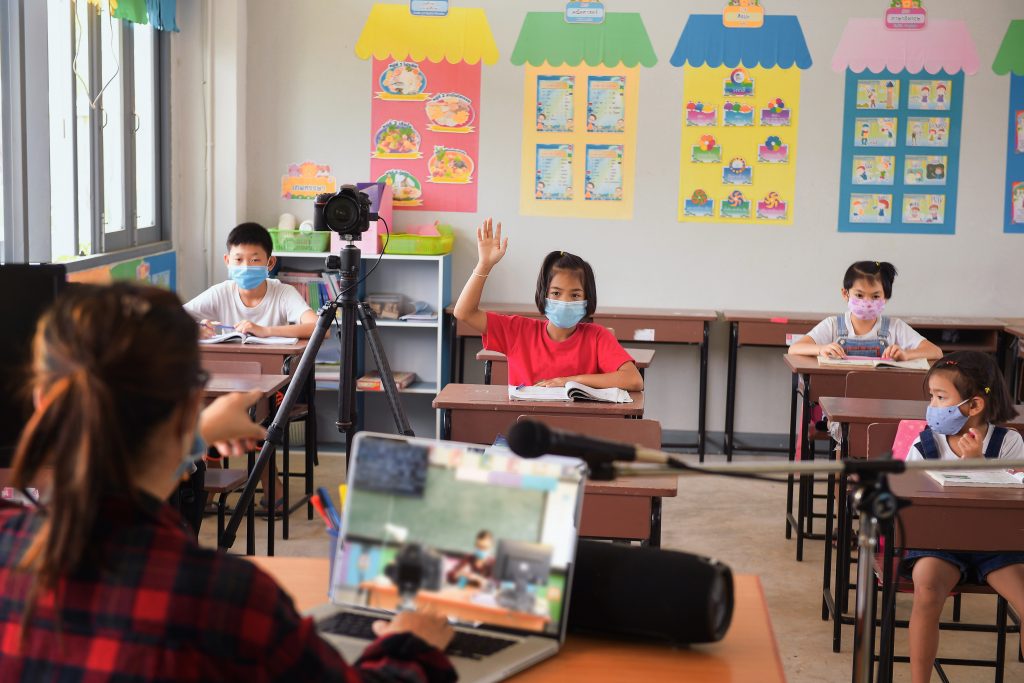As the end of August neared, it felt like a big change in my life was arriving. It had been almost one and a half years in a pandemic, stuck at home, and the feeling of eternity started to fog my mind. It seemed as if things would never go back to normal- I would never be able to be a regular high schooler who went to school, cheering at football games, connected with my teachers, and simply lived the “high school experience.” Soon enough, hope arrived. My parents got an email from the school district saying that schools would return to in-person learning- but with a mask mandate. I let out a sigh of relief. I would finally be able to have some normalcy in my life, but little did I know how much was going to change.
Transitioning from a full year of virtual school to in-person school was a big change for students across the nation. For elementary schoolers, it might have meant their first time actually going to school and leaving their parents- but this time with masks. Elementary school is essential to helping a child develop the social and educational skills that they utilize for many years to come. It is definitely something that requires a lot of support, which studies have shown was difficult for teachers to provide through a laptop during virtual learning. In fact, a study by Stanford researchers has shown that virtual learning had a detrimental impact on elementary students’ reading skills. Especially 2nd and 3rd graders struggle with fluency, and there was a 30% drop in fluency nationally. This clearly shows how different virtual learning was from in-person learning, thus contributing to the idea that the transition is huge for children as young as six years old since learning and communication styles would change.
In addition to it being a major transition for elementary schoolers, I can personally vouch for the fact that as a high schooler, transitioning to a more normal education after learning for the last one and a half years has been difficult. Learning from home has its advantages and disadvantages. I enjoyed being able to study and work at my own pace while also saving time by not having to commute to and from school. On the other hand, I wasn’t able to meet many new people and connect to my teachers because of the barrier of technology between us. Most importantly, because of the long period of time virtual school was in place, it had essentially become a routine- something many other students and I were so used to. This made going back to in-person learning an immense change. From the small things like having to wake up extra early to pack a lunch to take tests on paper with a pencil, it definitely increased my stress levels on top of already being in junior year of high school. In fact, the transition to in-person school was proven to be especially hard for introverted students. During virtual learning, they didn’t have to cope with the social and emotional pressures that came from engaging with people every single day. This is directly supported by Robyn Mehlenbeck, director of the Center for Psychological Services at George Mason University, who stated, “For children with social anxiety, virtual learning took away the social pressures to look or act a certain way.” Going back to school inevitably meant these pressures returning and navigating a way to cope.

With our world constantly changing by the moment, it is essential that we support one another and ask for help when we need it. Students should reach out to their teachers or any trusted staff member if they are struggling to keep up in class due to the big adjustment. Teachers can also help ease the stress by understanding how different these last few years have been for students and display empathy when it comes to a child struggling or genuinely needing extra support. Finally, parents can make sure to encourage their children to let them know if they need any help and assure them that it’s okay to feel out of routine with our worlds constantly changing. At the end of the day, we are all a part of this pandemic together; therefore, we should focus on coping and growing together.
References:
- Louie, David. “Distance Learning Hurt Elementary School Students’ Reading Skills, Stanford Study Shows.” ABC7 San Francisco. KGO-TV, March 10, 2021. Stanford study says distance learning hurt elementary school students’ reading skills – ABC7 San Francisco (abc7news.com)
- Karimi , Faith. “Some Kids Don’t Want to Return to in-Person Schooling.” CNN, August 15, https://www.cnn.com/2021/08/15/us/back-to-school-anxieties-wellness/index.html.

















